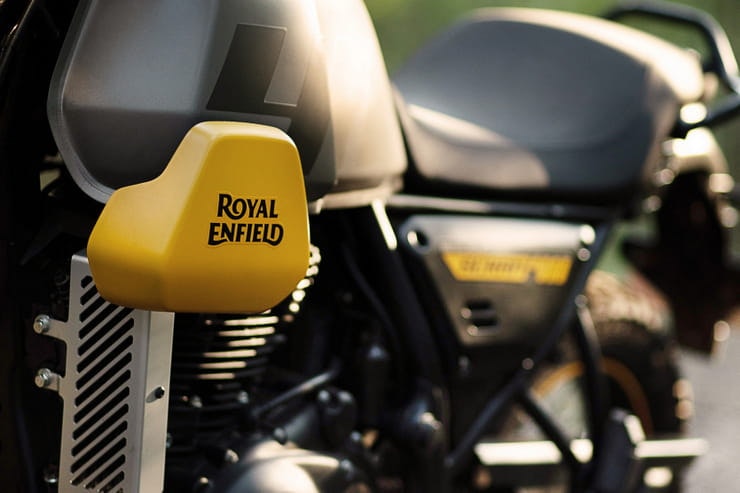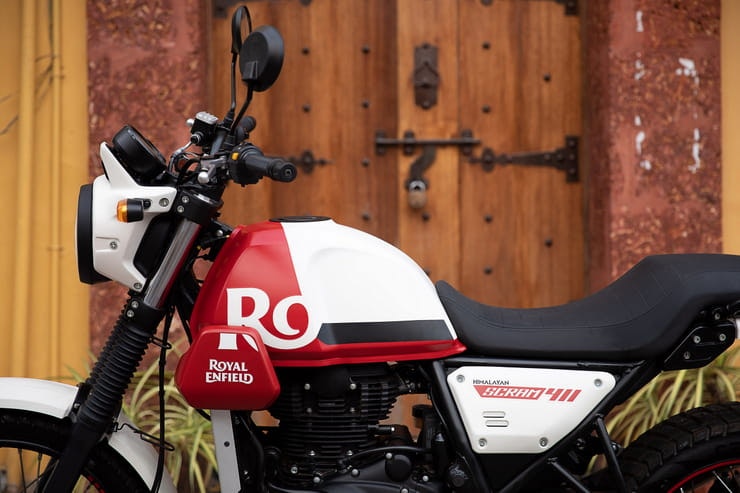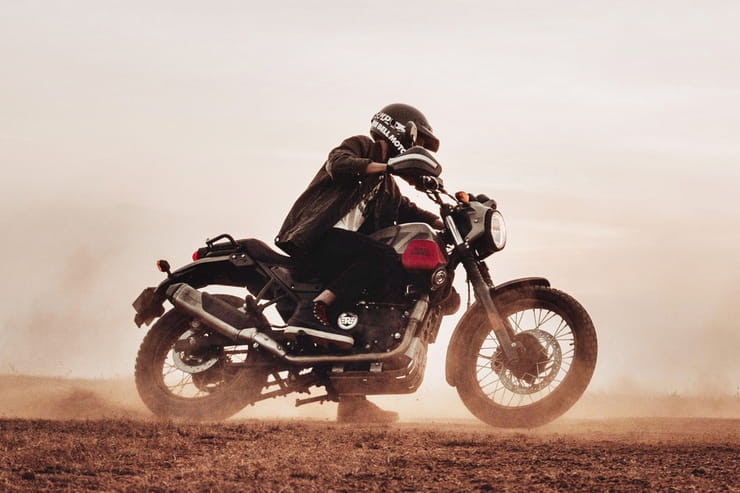Royal Enfield Scram 411 (2022) - Review
By Steve Rose
BikeSocial Publisher since January 2017.
20.05.2022
Tech Review by Ben Purvis
Review – In Brief
Stylish, well put-together, simple
Air-cooled engine has more performance than the numbers on the spec-sheet suggest but is still A2 licence compliant
Predictable handling and easy to ride
Good value
Top speed (and increasingly loose handling) around 80mph means motorways are best avoided
Suspension and brakes are fine at most speeds but not quite up to the limits of the engine’s performance
Verdict: Royal Enfield’s Scram 411 is a stripped-back roadgoing version of the A2-licence compliant Himalayan adventure bike. A smaller front wheel gives sharper steering and the riding position is a little less upright. The engine and chassis work well in town with power where you need it to get through the traffic and nimble-but-stable handling too. Back to basics biking in a cool-looking package at a good price with three years’ warranty.
Heavily based on the existing Himalayan, borrowing the same frame, engine, suspension and even the fuel tank, the Scram has a more road-oriented style and design focus, which along with reduced weight makes it a little more nimble without sacrificing too much of that machine’s off-road ability.
Price
Simplicity
Ease of use
Three-year warranty
Suspension at speed
Long motorway journeys
No centre stand
Price
Engine, Gearbox and Exhaust
Handling & Suspension and Weight
Comfort & Economy
Brakes
Rivals
Verdict
Specification
Royal Enfield Scram 411 Price
At £4599 the Scram is £100 cheaper than the base model Himalayan and only a few hundred quid more expensive than the Chinese 400cc retros. Royal Enfield haven’t announced finance packages at the time of writing, but assuming they do a similar offer to the Himalayan, you’ll be looking at £99 deposit, 49 payments of around £80 at 6.9% APR and a final payment of £1500 to own it at the end.
Aside from the Chinese manufacturers there isn’t a lot of competition for the Scram to fight off. The Japanese manufacturers don’t really do single-cylinder bikes above 125cc, BMW’s G310 is similar on paper (also built in India) but in the flesh has a different vibe about it and costs £600 more.
2022 Royal Enfield Scram 411 Power and torque
24hp at 6500rpm is half as much as an A2 rider is allowed. That comes on the back of 23.6 lb-ft of torque reached at 4250rpm. There’s no rev counter so you ride by feel and soon forget about the numbers because you’re keeping up with traffic and have enough power for a cheeky overtake.
2022 Royal Enfield Scram 411 Engine, gearbox, and exhaust
The Scram’s 411cc motor is straight from the Himalayan. That means it’s a single overhead cam, two-valve, air-cooled, single cylinder design, with a longer piston stroke than cylinder bore that gives a wide spread of torque instead of high-revving power.
It’s bolted to a gearbox that makes do with five ratios rather than the more common six, but if you’re prepared to embrace the simplicity as a virtue rather than a drawback that’s not necessarily a bad thing. The exhaust is also from the Himalayan, which was updated last year to meet Euro 5 emissions limits.
Enfield’s 411cc air-cooled single might not worry the A2 licence regulators, but that doesn’t mean it’s slow or boring or only of interest to new riders. It’s an easy-to-use, flexible motor that punches way above its weight if you make the mistake of judging it by the numbers.
Pushing a 200kg motorcycle through the air with just 24bhp and 23lb-ft of torque sounds like it’ll be not much quicker than a 125cc learner bike. The reality is a lot different. There’s plenty of low-down power to get you off the line at traffic lights, enough mid-range for relaxed cruising up to 60mph and then enough top-end power to see 80mph on the speedo should the thing you are overtaking turn out to be going quicker than you thought.
More importantly, the fuel-injection is set-up to deliver that low-down and midrange power easily and smoothly without the spluttering or coughing that used to afflict single-cylinder bikes with carburettors at low revs. This means the Scram has accessible torque and drive pretty much anywhere in the rev range and is as happy doing 60mph in third gear as it is in fifth.
On paper (and on motorways if we’re honest) a top speed of 80mph only just sounds like enough, but on A-roads, B-roads and in town the Scram never feels stressed. It’s got a lot of the same relaxed nature and charm of a Harley Davidson motor but without the noise and the tantrums at low revs or the stiff, noisy gearchange that scares the birds out of trees when you change up.
The Scram’s gearchange is slick, neutral is easy to find at a standstill and the clutch is light and predictable – just what you need if you’re new to riding or returning after a long break.
We didn’t do enough miles on the launch day to get a meaningful MPG figure, but we know that the same engine in the Himalayan – basically the same package - does an easy 80mpg so we’d expect similar on the Scram. That gives a theoretical range of at least 265 miles from the 15-litre fuel tank.
2022 Royal Enfield Scram 411 Handling, suspension, and weight
The Scram’s 41mm, right-way-up forks are like those of the Himalayan, with slightly less travel at 190mm instead of 200mm. That’s still far more than the average bike, and should be useful if you venture off-road. At the back there’s a preload-adjustable monoshock with 180mm of wheel travel, just like the Himalayan.
Those who look at the Scram’s marketing material and dream of feet-down, flat-track, sideways scrambling-type action are going to be disappointed unless you’ve already spent ten years riding off-road or been on the Enfield slide-school. The Enfield is a capable road bike that’ll give confidence in corners to riders still learning the dark arts of motorcycle cornering.
The biggest change to the Himalayan’s chassis (designed by Harris Performance, is the switch from a 21-inch front wheel to a 19-inch rim. Along with the shorter fork travel that drops the Scram’s front end, sharpening the steering compared to the Himalayan, while simultaneously chopping 10mm from the wheelbase, from 1465mm to 1455mm.
A more impressive cut comes in the weight, which is slashed from the Himalayan’s 199kg to 185kg. Those numbers aren’t necessarily comparable, though – the Himalayan’s 199kg is measured 'in running order’ (suggesting a tank of fuel) while the Scram’s is without petrol. Filling the 15-litre tank will add around 11kg in petrol, pushing the Scram to 196kg in fully fuelled form.
In reality this means that the Scram turns easily and predictably, doesn’t drop suddenly into a corner halfway round, has enough ground clearance to not scare you with a sudden scrape of footpeg and a soft-enough power delivery that you can experiment with getting on the gas as the corner opens out without fear of anything scary happening.
The smaller front wheel and sharper steering geometry is most noticeable when nipping in and out of urban traffic.
Suspension is soft and a little bouncy. Enfield’s press presentation showed pictures of typical Indian potholed roads suggesting that the Scram was built to deal with them. It isn’t and, if I’m honest I was disappointed with how it crashed and banged up and down on some ‘not-nearly-as-bad-as-UK-potholes-can-get’ urban streets. It’s much better if you stand up on the footpegs as you’d expect on a bike developed from an adventure machine but standing up in town for any length of time feels unnecessary and you lose fine control of the throttle and brakes.
There’s enough suspension control through corners on bumpy back roads though. You can adjust the preload on the rear spring to set the bike up when adding a passenger, but that’s all the available adjustment.
Part of the test ride (because we’re all still young-at-heart) was to see how fast the Scram would go and the most suitable place was a quiet-but-bumpy back road with a half-mile straight. At 60mph, the Scram was perfectly behaved. By 70mph it was starting to feel a little loose as the suspension bounced over bumps instead of soaking them up. By 80mph (pretty-much flat-out) the handlebars were starting to flap as the front and rear suspension lost the battle to respond to bumps quickly enough.
Royal Enfield Scram 411 2022 Royal Enfield Scram 411 Comfort and equipment
With a 795mm seat height the Scram sits 5mm lower than the Himalayan, making it a fraction more accessible to those with shorter legs (but still comfortable for those of us troubling the second metre of the measuring tape). Handlebars are the same but sit lower because of the smaller front wheel and shorter fork travel to make for a less parachute-like riding position adding some comfort on longer runs.
One of Royal Enfield’s selling points is their simplicity and that extends to equipment. The brakes have a rudimentary ABS system, the speedometer has a small LCD display showing mileage, trip meters, a clock and a fuel gauge. There are no riding modes or traction control or ability to Whatsapp your dog on the move, but it does have Royal Enfield’s ‘Tripper’ turn-by-turn navigation, which is powered by Google maps via an app on your smartphone.
Brakes
The brakes, are borrowed straight from the Himalayan, with a 300mm front disc and 2-piston caliper aided by a single-pot rear caliper and 240mm disc. There’s dual-channel ABS, to meet legal requirements, but that’s the extent of the assistance.
They are effective without being over sharp, which is perfect for the new-ish and returning riders that the Scram is aimed at. There is plenty of feel to allow riders to just scrub off a bit of speed in traffic and, when used together there’s enough power to bring the bike to a halt when and where you need it to be. You won’t win any track days (unless it’s a track day full of Enfield singles) by braking latest and hardest, but you will learn that smart riders look a long way into the distance, assess the traffic and the road and use their brakes as a control, not a weapon.
Finding a direct competitor for the Scram 411 is hard work – there aren’t many scrambler-style machines out there in the 400cc class.
In many ways, the Scram is more likely to be an alternative to the Himalayan than to other new bikes, appealing to customers who like the idea of the Himalayan’s simplicity but can’t get on with its utilitarian looks. Other than that, rivals are spread from lightweight, cheap 250cc scramblers to pricier 500cc-class machines.
For those with a full licence the real competition for the Scram will come from the second-hand market – a 2015 Ducati Scrambler with less than 10,000 miles on the clock could be had for around the same cost as a new Scram 411, and there was even the Sixty2 model for riders who really want a 400cc machine.
2022 Royal Enfield Scram 411 Rivals
2022 BMW G310R | Price: £5137
40kg lighter with 10bhp more than the Scram – the G310R is more of a mini streetfighter than a retro scrambler. The suspension and brakes are stronger too. If outright performance matters, it’s possibly a better buy. But the Scram has more charm and feels less disposable than the BMW. We think you’d keep it (and love it) for longer
Power/Torque: 34bhp/20lb-ft | Weight: 158kg
2022 Royal Enfield Himalayan | Price: £4699
Massively popular low-tech adventure bike on which the Scram is based. A bigger front wheel works better off-road. Early models had some teething troubles, but these have all been fixed and the Himalyan has a strong and loyal following.
Power/Torque: 24bhp/23lb-ft | Weight: 200kg
2022 Husqvarna Vitpilen 401 | Price: £5049
Retro-styled roadster uses KTM’s 390cc single cylinder engine (Husqvarna are owned by KTM). Funky, stylish, A2 compliant, lovely to ride and there are some significant discounts off rrp if you shop around
Power/Torque: 44bhp/27lb-ft | Weight: 148kg
2022 Royal Enfield Scram 411 Verdict
Three years ago I moved house from Lincolnshire (empty, packed with brilliant fast, twisty biking roads) to Sussex (busy and the only quiet roads are tiny, narrow lanes) and have spent most of that time trying to find a suitable bike to enjoy this part of the world on. This Royal Enfield Scram might just be the perfect solution because it makes 60mph roads really enjoyable without being stressed and encourages a slightly more gentle pace on two wheels. A bit like a Harley without the cost or the chrome or the sneers from the rest of motorcycling.
We think Royal Enfield’s road-focused version of its popular Himalayan is going to be just as well-loved as its dad. The styling is sharper and less utilitarian and the performance and ride are spot-on for Enfield’s growing tribe of back-to-basics, value-seeking customers.
This is a first-big-bike that you’re likely to keep for longer than you thought because (motorways aside) it does pretty much everything you’d want a bike to do in a straightforward, unpretentious manner.
I found myself thinking words like ‘pleasant’ and ‘charming’ top describe the Scram which are a long way from the macho nonsense that fuels so much of mainstream motorcycle language. That’s a good thing by the way and if you see biking as something that happens in a relaxing-but-efficient manner on Monday-Friday as well as weekends, you should definitely get a test ride.
Royal Enfield Scram 411 (2022) Technical Specification
Photos: Jason Critchell
What is MCIA Secured?
MCIA Secured gives bike buyers the chance to see just how much work a manufacturer has put into making their new investment as resistant to theft as possible.
As we all know, the more security you use, the less chance there is of your bike being stolen. In fact, based on research by Bennetts, using a disc lock makes your machine three times less likely to be stolen, while heavy duty kit can make it less likely to be stolen than a car. For reviews of the best security products, click here.
MCIA Secured gives motorcycles a rating out of five stars, based on the following being fitted to a new bike as standard:
A steering lock that meets the UNECE 62 standard
An ignition immobiliser system
A vehicle marking system
An alarm system
A vehicle tracking system with subscription
The higher the star rating, the better the security, so always ask your dealer what rating your bike has, and compare it to other machines on your shortlist.


